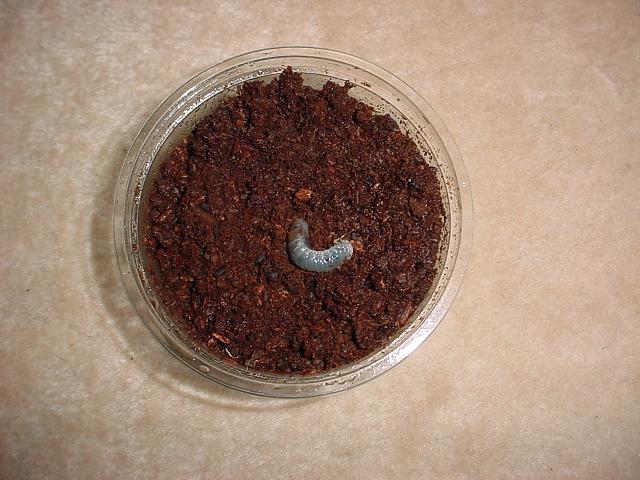The
Breeding/Rearing of Dynastes hercules hercules (page
2)
- Yasuhiko Kasahara
-
3. Breeding/rearing10
3.1 Getting started
To begin with, what you need are:
1) An imago pair (or several
larvae);
2) Containers for breeding/rearing;
3) Food for imagoes; and
4) Substrate for breeding/rearing
 .
.
| Figure 3.1
A first-instar (L1) larva of Dynastes hercules hercules |
|
1) Please obtain an imago pair (or several
larvae). In choosing which individuals to buy, the following criteria are
useful:
a) Wild-caught individuals:
Make sure: - When were they collected?: Avoid older individuals.
- Are they healthy-looking?: Check if there is no scar, injury
or missing part.
b) Captive reared individuals:
Make sure: - When did they emerge?: Avoid individuals of 8 months or older.
- Are they healthy-looking?: Check that there is no scar, injury
or missing part.
* Note that these two
criteria are for imagoes. For choosing larvae, you can skip steps: - When
were
they collected?
and - When did they emerge?
2) Oviposition (egg laying) requires
some space; e.g. a large container with a capacity of 45-60 liters (an
example is a fish tank, and a lid is a must to stop the beetles from escaping).
Get one and fill it with substrate (see 4. A breeding/rearing
substrate).
- Put substrate into the container up to
20 cm high from the bottom, and press it hard by hand or any other means.
Then, another 10 cm depth of substrate should be added, unpressed, to the
top of the layer. Often times, the female prefers depth and lays eggs in
the hard-pressed bottom layer.
- It is good to place several small tree
branches or wood sticks on the surface of the substrate. By holding them,
beetles can easily get up in case they turn upside down on their backs.
- Then, place a pair of beetles into the
container. Feed them regularly (for food, see 3)).
- Keep the temperature at 20-26 degrees
C. and moisten the substrate adequately.
3) For maintaining imagoes, you
need to feed them with a peeled banana. It is better to place its pieces
or slices on a small tray instead of applying them directly on the substrate,
which causes them to spoil faster or prompts an occurrence of fruit flies
or ticks (mites). I hear that a peeled apple or a peach also serves as
a suitable food.
4) See 4. A breeding/rearing
substrate.
3.2 Rearing larvae
One or two months after you place the imago
pair in the breeding container, look into the substrate to see if larvae
have already hatched. If so, take the imagoes out of the container, and
keep the larvae in the container until they become second-instar (L2)*.
To win better results of larval growth, keep males separated from females
at L2 stage and transfer the males singly into large rearing containers,
preferably of a 45-60 liter capacity. However, if you do not expect males
to grow to a maximum, you can rear them together in a fairly large container
or put them singly into a container of a smaller capacity (e.g. 5-6 liters).
For females, you can rear them together in a large container. But, the
fewer in number, the larger they seem to grow. But again, if you also expect
females to grow to a maximum, you should put them singly into a container
of 5-6 liters in capacity.
* If you wish to
obtain more eggs, place the imago pair into another breeding container.
Repeat this
process if you
want.
(continued
on next page) |